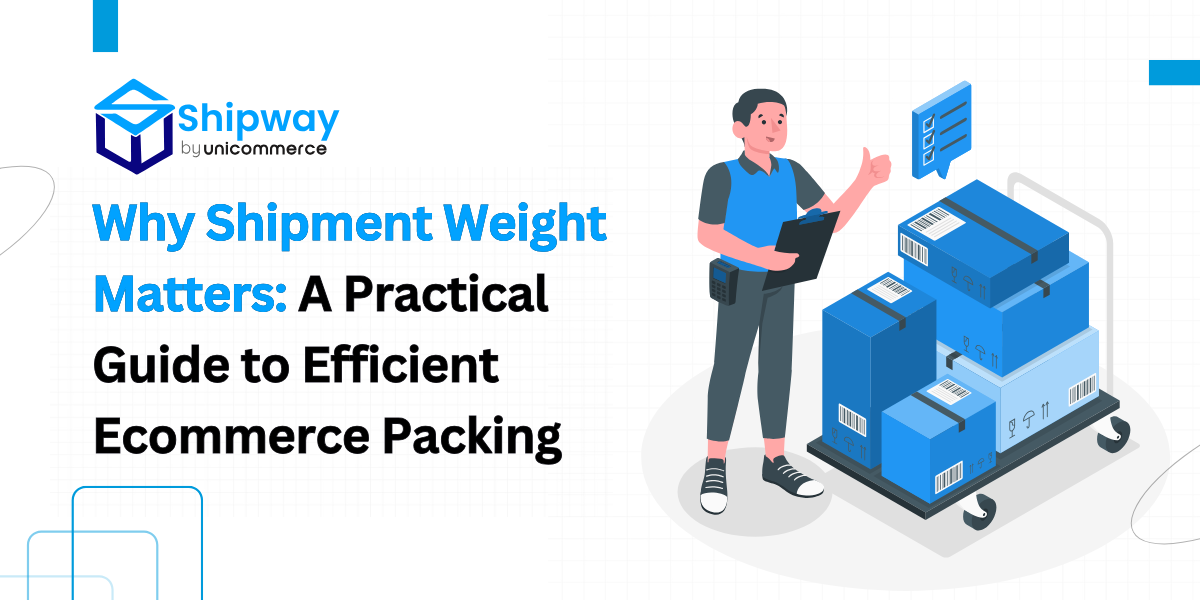Efficient packing reduces weight disputes and saves time. It also saves money and prevents any kind of shipment delays. Ecommerce businesses often face many challenges when shipping products. And in this weight issues are among the most common problems. Weight disputes in e-commerce shipments result in extra fees, delays at shipping checkpoints, and unhappy customers.
This article explains what efficient packing is, why accurate weight matters, and how to avoid disputes with careful packing methods. We provide practical tips and clear steps. You will learn how to choose the right materials, measure weights properly, and work with your team and carriers to keep online shipments running smoothly.
What Is Efficient Packing?
Efficient packing is a method of preparing shipments that minimizes extra weight and prevents disputes. It means choosing the proper box, filler, and packing materials so that the total weight matches what is declared by shipping companies.
Efficient packing helps protect your orders and saves you from extra charges. It stops unwanted materials from adding extra weight. A well-packed shipment does not require additional filler and it gives the correct weight reading. Your business runs perfectly when you pack items efficiently and you have fewer problems at the shipping counter.
The key points of efficient packing include:
- Selecting the proper box: Use a container that fits the product snugly.
- Using minimal filler: Only add what is necessary to secure the item.
- Weighing accurately: Measure both the product and the packaging.
- Following set procedures: A consistent method keeps errors to a minimum.
- Training staff: Everyone involved understands the correct process.
By following these steps, your shipment weight is closer to the declared value, and disputes become less likely.
Why Accurate Shipment Weight Matters?
Accurate weight is the backbone of excessive shipping costs. In the ecommerce industry, carriers calculate fees based on weight. In this, any discrepancy can lead to extra charges or delays. When the weight on a shipping label is incorrect, you may face questions or fees at checkpoints.
Shipping companies and customs officials rely on the declared weight for tax calculations and fee assessments. A small error in weight can cause a lot of issues over time. This becomes more difficult when you ship many orders. In this, consistent errors can result in a backlog of disputes, extra administrative work, and even strained relations with carriers.
To avoid any type of problem, accurate weight measurement is important. When the package weight is accurate, your shipments move quickly, costs are kept in check, and customers receive their orders on time. This accuracy builds trust between you and your shipping partners. And it saves you from having to resolve weight disputes after the fact.
Common Causes of Weight Disputes
Weight disputes in ecommerce shipments usually occur when the declared weight does not match the actual weight of the package. There are several common causes behind these discrepancies:
Extra Materials
Many sellers add too many packing materials to protect fragile items. Extra tape, heavy filler, or oversized boxes can contribute unwanted weight. While the extra protection may seem beneficial, the added weight can lead to disagreements with shipping companies.
Inaccurate Measurement Tools
A small error on a scale can lead to significant discrepancies. If your scale is not calibrated properly or if it is old, you may end up recording the wrong weight for a package. These errors multiply when hundreds of packages are processed daily.
Inconsistent Packing Methods
When different staff members use varying methods to pack shipments, the amount of filler and the type of box can vary from one package to another. This inconsistency can lead to weight differences that create confusion during shipment processing.
Changes in Packaging Materials
Sometimes suppliers change their packaging materials or dimensions without clear communication. A slight change in the box design or filler material can alter the overall weight of a shipment. Such variations can cause disputes if the new weight is not properly documented.
Environmental Factors
Weather, moisture, and even dust can sometimes affect the weight of a package. A box that absorbs moisture or picks up debris may weigh more than expected when measured. Although these changes are minor, they can add up over multiple shipments.
Understanding these causes helps you design a process that minimizes errors. When you know where extra weight may come from, you can take steps to stop it before it becomes a problem.
Top 8 Packing Strategies Every Ecommerce Business Should Follow
Implementing efficient packing strategies can greatly reduce the number of weight disputes you face. The following strategies offer practical ways to keep your shipments accurate and your costs low.
1. Choose the Right Box
Selecting a box that fits your product properly is essential. A box that is too large forces you to use extra filler material. On the contrary, a box that is too small may not protect the item adequately. The ideal box has just enough space for the product and a minimal amount of protective material.
- Fit: The box should fit the product without much extra space.
- Strength: It must be sturdy enough to protect the item.
- Weight: Lighter boxes are preferred as they add less weight.
2. Use Minimal, Lightweight Filler
Filler materials are necessary to secure your product, but they should be used sparingly. Choose fillers that are light in weight yet strong enough to cushion the item. Materials such as bubble wrap, air pillows, or foam sheets are good options if used in the right amount. Avoid excessive use of heavy-packing peanuts or multiple layers of tape.
- Bubble Wrap: Provides protection without much added weight.
- Air Pillows: Light and effective for void fill.
- Foam Sheets: Offer good cushioning with minimal weight.
3. Weigh Each Component Separately
One of the best ways to avoid discrepancies is to weigh each component of your shipment separately. Measure the product, the empty box, and the filler material individually. Then add these weights to obtain the total package weight. Doing so ensures that you catch any errors early.
- Step 1: Weigh the product on a calibrated scale.
- Step 2: Weigh the empty box.
- Step 3: Weigh the filler material.
- Step 4: Sum all the weights.
- Step 5: Compare the total with the declared weight.
This process not only provides accuracy but also creates a record that can be referred to if disputes arise.
4. Train Your Staff Thoroughly
A well-trained team makes all the difference in packing efficiently. Every team member must understand the importance of using the correct box, minimal filler, and accurate weighing techniques. Training should be ongoing, with periodic refreshers to ensure everyone remains up to date with the procedures.
- Conduct regular training sessions.
- Provide a written guide and checklist.
- Hold practical demonstrations to show the correct process.
- Encourage questions and feedback from the team.
When everyone is on the same page, your packing process becomes consistent, and errors drop significantly.
5. Establish Standard Operating Procedures (SOPs)
Having clear and documented procedures is key to maintaining consistency. A standard operating procedure for packing ensures that everyone follows the same steps every time. Your SOP should include instructions on choosing boxes, using filler, and weighing components. This document acts as a reference and helps new employees learn the process quickly.
A sample SOP might look like this:
- Select the Appropriate Box: Choose a box that fits the product with minimal extra space.
- Prepare the Filler: Use only the necessary amount of lightweight filler.
- Pack the Product: Place the product in the box securely.
- Weigh the Empty Box: Record the weight of the box without any filler.
- Add the Filler: Introduce the filler and measure its weight.
- Weigh the Final Package: Record the total weight and verify it against shipping documents.
- Record and Log: Maintain a log for future reference and quality checks.
Following an SOP ensures that your process is repeatable and reduces the chance of human error.
6. Use Quality Measurement Tools
You need to invest in good quality digital scales and measuring devices as a smart move. This is because these tools help in making sure that your weight readings are accurate. Regularly check and calibrate your scales to prevent drift in measurements. Even a slight miscalibration can lead to significant errors over time.
- Digital Scales: It provides fast, accurate readings.
- Calibration Weights: Make sure that the scale remains accurate.
- Automated Systems: Some systems integrate with inventory software to log weights automatically.
7. Maintain Clear Communication with Carriers
Clear dialogue with your ecommerce shipping partner can help avoid any type of dispute. When you work closely with carriers, then you can set clear expectations about how weight is measured. Discuss your packing process with them and understand how they verify package weight. Such communication can prevent misunderstandings and make dispute resolution easier if issues arise.
- Share your SOP with carriers.
- Clarify how packaging components are measured.
- You need to agree on how to handle minor discrepancies.
- Always establish a point of contact for weight disputes.
8. Regularly Audit Your Packing Process
Periodic audits always help in identifying issues before they become widespread. This is because auditing your process can reveal inconsistencies, equipment problems, or training gaps. You need to use audits as an opportunity to update procedures and reinforce best practices. A simple checklist can guide your audit process.
Conclusion
Efficient packing and accurate weight measurement processes pave the way for ecommerce success. They help you avoid unnecessary shipping costs, speed up delivery times, and maintain customer trust. But even with the best internal processes, you need a reliable shipping partner to truly minimize disputes.
That’s where Shipway stands out. Shipway proudly holds the lowest weight dispute rate in the industry, thanks to its advanced systems and relationships with courier services. Plus, Shipway offers dedicated support and hands-on assistance to help ecommerce businesses reduce weight discrepancies even further.
By partnering with Shipway, you not only streamline your packing and shipping operations but also ensure smoother deliveries, fewer disputes, and greater customer satisfaction — every single time.
You may also like…
7 Proven Ways to Improve Delivery Ecommerce Performance with Shipway
Delivering products swiftly and reliably has become a decisive factor for winning and retaining customers in ecommerce delivery. Fast delivery...
read more10 Questions to Ask Before Choosing a Shipping Partner for Your E-commerce Business
Top 10 Questions to Ask Before Choosing a Shipping Company Setting up an e-commerce business is just one step on the ladder to success, but...
read moreTop 10 Logistics Companies in India for eCommerce (2025 List & Guide)
Introduction: Why Logistics Matters for India’s Growing eCommerce Sector The Indian eCommerce sector has witnessed tremendous growth, projected to...
read more





